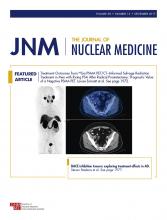REPLY: Thank you for allowing us to respond to Drs. Hans-Jürgen Machulla and Ehab Al-Momani, who point to the recently established preclinical utility of 18F-AlF2+ as an alternative radiometal-like moiety for low-temperature radiolabeling of radiometal-complexing agents conjugated to prostate-specific membrane antigen (PSMA) ligands for prostate cancer PET imaging. We also gratefully acknowledge their comments on our articles (1,2) questioning the need for radiofluorinated PSMA PET tracers in addition to the 68Ga-labeled versions already available as a diagnostic version of theranostic ligands, and we appreciate their perspective on 18F-labeled PSMA tracers. Indeed, in recent years several 18F-labeled PSMA radioligands apart from the mentioned 18F-AlF2+–labeled variants have already been introduced both preclinically and clinically (3–5). Particularly, Szabo et al. (4) clinically introduced 18F-DCFPyL, an improved second-generation 18F-PSMA ligand, which was followed by the work of further optimized next-generation PET tracer 18F-PSMA-1007 recently introduced by Giesel et al. (5). Both 18F-labeled ligands have already entered prospective clinical trials, highlighting the obvious high potential of these radiofluorinated tracers for the primary diagnosis of prostate cancer and detection of relapse by means of PET/CT and PET/MRI. In this connection, the good manufacturing practice–compliant procedures for the production of these radiofluorinated PSMA ligands have also already been established to cover all regulatory prerequisites. Regardless, the 18F-AlF2+–labeled versions of PSMA ligands originally intended for radiometal labeling (e.g., 68Ga and 177Lu), despite sophisticated and successful radiolabeling, again have to be carefully preclinically evaluated. This is necessary for every PSMA tracer bearing a new radiolabel moiety, and in this case especially, potential defluorination in vivo has to be considered. However, only limited preclinical results in vitro and in vivo are available for 18F-AlF2+–labeled PSMA ligands. The major concern is the necessary elucidation of maintained binding affinity and internalization properties after 18F-AlF2+ labeling of the theranostic PSMA ligand of interest and, finally, examination of the pharmacokinetic properties in vivo. In this respect, we are looking forward to seeing the first-in-man data obtained with 18F-AlF2+–labeled versions of PSMA ligands proving their clinical impact, including acceptance as indicated by the necessary urooncologic referrals. In any case, we strongly appreciate the comments of Drs. Machulla and Al-Momani and agree with their statement that 18F-labeled PSMA ligands are essential in the future not only because of the advantageous nuclear properties of 18F but also to cover the clinical demand in daily patient care by offering large-scale batches of the respective 18F-tracer. We are strongly convinced that, depending on the hospital and PET center environment and infrastructure in countries with reduced clinical demand, 68Ga-labeled PSMA ligands will still play a clinical role in the future.
Footnotes
Published online Nov. 9, 2017.
- © 2017 by the Society of Nuclear Medicine and Molecular Imaging.







